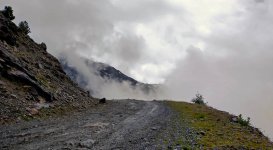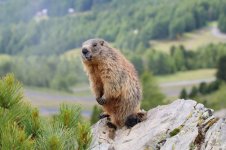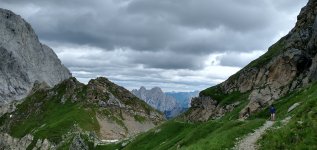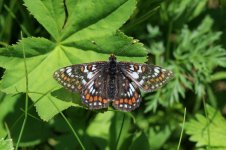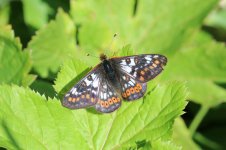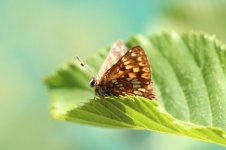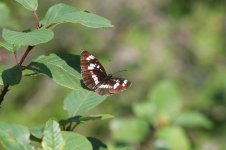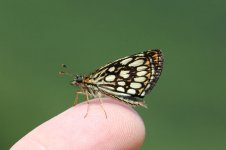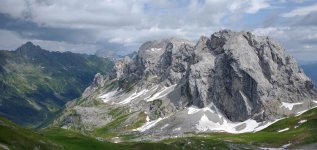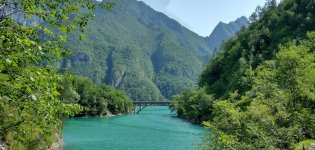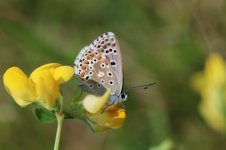
-
Welcome to BirdForum, the internet's largest birding community with thousands of members from all over the world. The forums are dedicated to wild birds, birding, binoculars and equipment and all that goes with it.
Please register for an account to take part in the discussions in the forum, post your pictures in the gallery and more.
You are using an out of date browser. It may not display this or other websites correctly.
You should upgrade or use an alternative browser.
You should upgrade or use an alternative browser.
Butterflies in the Italian Alps, 8-22 July 2021. (1 Viewer)
- Thread starter Jos Stratford
- Start date
More options
Who Replied?

16 July. Passo Stelvio.
A miracle - in total contrast to the forecast, the day dawned blue and cloudless. Made the most of it and departed Bormio fairly early for the short drive to Passo Stelvio, the second highest paved road in Europe at 2760 metres. At 8.30 am, still in full sunshine and an almost balmy 6 C, I stopped a half dozen kilometres short of the pass and began my exploration, altitude 2200 metres. Superb! Excellent butterflies from the offset - several Mountain Clouded Yellows, a number of Alpine Graylings, a splendid Glandon Blue (a new species for me), several Mountain Argus. And then my Holy Grail, flitting from flower to flower, ghostly white patches on the underwing, one male Alpine Blue. After two days of fruitless searching, and a complement to my Arctic Blue one year earlier in Norway, here was the main target of my whole trip ...it certainly evoked a little whoop of joy. I found four at this little spot, a sheltered gully of mixed scree and flower patches. Got nice photographs of the uppersides, failed to photograph the characteristic underwing though ... fortunately this would be remedied a few days into the future. Also added an Eros Blue here too, plus Silver-spotted Skippers and Mnestra’s Ringlet.
About 3 km further, now a pleasant 12 C, another stop proved equally productive - among plenty of Alpine Heaths, Mazarine Blues and Little Blues, a few Dewy Ringlets, three Olive Skippers, a couple of Mountain Fritillaries and two Apollos. Highlight here however was the finding of a colony of Marsh Fritillaries - quite unlike the one I see in Lithuania, these were of the Alpine race, very pale and unmarked on the underwing. In the midst of these, one 'Heath Fritillary' also briefly landed ...hmm, 'dumbbell markings on the wings, should photograph that' thought I. Checking later, seems I found myself a Grison's Fritillary, a fairly rare high altitude species, new one for me.
By now mid-morning, I drove the last couple of kilometres up to Passo Stelvio itself, a remarkable ramshackle of tourist grockle shops and small cafes, all only open in the summer. Clambered up the adjacent peak for a quick walk in Switzerland, a couple of Dewy Ringlets and a Small Tortoiseshell the only butterflies seen, then settled down for a coffee in one of the open air cafes. Alpine Choughs tumbling around and, blimey, then a Lammergeier! Round and round it soared, even settling on rocks immediately adjacent to a hotel, it definitely seemed attracted to this small settlement. That was a bonus indeed!
Descending the eastern side of the pass, less good for butterflies - though one stop with a half dozen Glandon Blues, a Black-veined White and several Arran Browns couldn't be sniffed at. In reality however, I did not have a lot of time here - ahead of me was the longest journey of the trip, a five-hour hop over to the Veneto region for the next part of the trip. Arrived about 6 pm, checked into an apartment near Sappada.
A miracle - in total contrast to the forecast, the day dawned blue and cloudless. Made the most of it and departed Bormio fairly early for the short drive to Passo Stelvio, the second highest paved road in Europe at 2760 metres. At 8.30 am, still in full sunshine and an almost balmy 6 C, I stopped a half dozen kilometres short of the pass and began my exploration, altitude 2200 metres. Superb! Excellent butterflies from the offset - several Mountain Clouded Yellows, a number of Alpine Graylings, a splendid Glandon Blue (a new species for me), several Mountain Argus. And then my Holy Grail, flitting from flower to flower, ghostly white patches on the underwing, one male Alpine Blue. After two days of fruitless searching, and a complement to my Arctic Blue one year earlier in Norway, here was the main target of my whole trip ...it certainly evoked a little whoop of joy. I found four at this little spot, a sheltered gully of mixed scree and flower patches. Got nice photographs of the uppersides, failed to photograph the characteristic underwing though ... fortunately this would be remedied a few days into the future. Also added an Eros Blue here too, plus Silver-spotted Skippers and Mnestra’s Ringlet.
About 3 km further, now a pleasant 12 C, another stop proved equally productive - among plenty of Alpine Heaths, Mazarine Blues and Little Blues, a few Dewy Ringlets, three Olive Skippers, a couple of Mountain Fritillaries and two Apollos. Highlight here however was the finding of a colony of Marsh Fritillaries - quite unlike the one I see in Lithuania, these were of the Alpine race, very pale and unmarked on the underwing. In the midst of these, one 'Heath Fritillary' also briefly landed ...hmm, 'dumbbell markings on the wings, should photograph that' thought I. Checking later, seems I found myself a Grison's Fritillary, a fairly rare high altitude species, new one for me.
By now mid-morning, I drove the last couple of kilometres up to Passo Stelvio itself, a remarkable ramshackle of tourist grockle shops and small cafes, all only open in the summer. Clambered up the adjacent peak for a quick walk in Switzerland, a couple of Dewy Ringlets and a Small Tortoiseshell the only butterflies seen, then settled down for a coffee in one of the open air cafes. Alpine Choughs tumbling around and, blimey, then a Lammergeier! Round and round it soared, even settling on rocks immediately adjacent to a hotel, it definitely seemed attracted to this small settlement. That was a bonus indeed!
Descending the eastern side of the pass, less good for butterflies - though one stop with a half dozen Glandon Blues, a Black-veined White and several Arran Browns couldn't be sniffed at. In reality however, I did not have a lot of time here - ahead of me was the longest journey of the trip, a five-hour hop over to the Veneto region for the next part of the trip. Arrived about 6 pm, checked into an apartment near Sappada.
Adey Baker
Member
Excellent stuff, Jos. Alpine Blue was one of my 'super' mountain species on the Grossglockner and I've never had a sniff of one since then (I think it was back in 1998)

17 July. Passo Sesis (Sappada).
260 km to the west of previous sites, cloudy again. Target here was the beautiful Cynthia's Fritillary, a localised species that inhabits some of the highest Alpine slopes. From 1800 metres, I hiked up to the mountain pass at 2360 metres, a steep and (with no sun) butterfly-less climb. Still, a couple of pairs of Alpine Accentors on route, several Alpine Choughs and numerous Water Pipits. At the pass, skies totally overcast and very windy, I walked a ridge trail to slightly higher terrain near the Austrian border, prime habitat for Cynthia's Fritillary. Not a hint of sunshine however and not a hint of any butterfly of any description.
Numerous Alpine Marmots scampering around, one more Alpine Accentor and a Snowfinch. I milled around in the vague hope of some sunshine, eventually descending about 3 pm when it became clear that skies would remain cloudy.
Back at the car, I returned to even lower altitude, seeing the only butterflies of the day - all at roost, Small White, Green-veined White, Mazarine Blue, Little Blue, Chalkhill Blue, Heath Fritillary and Bright-eyed Ringlet.
260 km to the west of previous sites, cloudy again. Target here was the beautiful Cynthia's Fritillary, a localised species that inhabits some of the highest Alpine slopes. From 1800 metres, I hiked up to the mountain pass at 2360 metres, a steep and (with no sun) butterfly-less climb. Still, a couple of pairs of Alpine Accentors on route, several Alpine Choughs and numerous Water Pipits. At the pass, skies totally overcast and very windy, I walked a ridge trail to slightly higher terrain near the Austrian border, prime habitat for Cynthia's Fritillary. Not a hint of sunshine however and not a hint of any butterfly of any description.
Numerous Alpine Marmots scampering around, one more Alpine Accentor and a Snowfinch. I milled around in the vague hope of some sunshine, eventually descending about 3 pm when it became clear that skies would remain cloudy.
Back at the car, I returned to even lower altitude, seeing the only butterflies of the day - all at roost, Small White, Green-veined White, Mazarine Blue, Little Blue, Chalkhill Blue, Heath Fritillary and Bright-eyed Ringlet.

18 July. Passo Sesis.
A tale of two mountains! Seeing cloud over my target peaks (surrounding Passo Sesis), I decided to hike up a neighbouring sun-dappled mountain. Some early success, seeing Apollo, Thor's Fritillary and Large Ringlets, but the sun had disappeared by the time I was at altitude and spots of rain were falling. Thoughts of higher slopes evaporated, I returned to the valley bottom where sunshine still prevailed and butterflies such as Swallowtail, Clouded Yellow and Heath Fritillary flew.
To the east, however, the tops around Passo Sesis now seemed somewhat brighter, so I relocated and once again slogged up the steep slopes to the lands of Cynthia's Fritillary. Cloud hugging the peaks on arrival, but no way I was descending again, I had put in too much effort, so instead I stubbornly remained in place eyeing the sky for a break in the clouds. With two layers of clouds moving in opposite directions, occasional blue patches never seemed to hit the exact mountain I was atop, frequently the slopes in Austria would be bathed in sun, occasionally those behind me in Italy. Five Griffon Vultures made for good distraction, but it wasn't until fairly late in the afternoon that gaps in the clouds aligned and finally a bit of sunshine hit my location - a grand total of 15 minutes of moderately weak sun, blighted by a rather windy conditions! It was enough though to get a few butterflies up and about - tops being a few Blind Ringlets and a Silky Ringlet. And then, just prior to the sun once again vanishing, a glimpse of a high-velocity butterfly catching the wind and hurtling across the slopes. I couldn't swear that it was not a moth of some sort, but it appeared fritillary-like and boasted a bright orange band at the rear and a piebald front half ... intriguingly similar to what a male Cynthia's Fritillary should look like. Moments later, it or another appeared on another slope nearby - again fast flying and not settling, this was almost certainly the real deal, a male Cynthia's Fritillary. Then it totally clouded over, end of butterflies. Frustrating, almost certainly I had found my target, but it was not enough.
I decided that was that and descended. Sunshine on the lower slopes and, saving the day in true style, I then found an Alpine Blue ...an Alpine Blue gracious enough to allow me to photograph the underwing. One Eros Blue and two Little Blues at the same locality, not a bad end to the day.
A tale of two mountains! Seeing cloud over my target peaks (surrounding Passo Sesis), I decided to hike up a neighbouring sun-dappled mountain. Some early success, seeing Apollo, Thor's Fritillary and Large Ringlets, but the sun had disappeared by the time I was at altitude and spots of rain were falling. Thoughts of higher slopes evaporated, I returned to the valley bottom where sunshine still prevailed and butterflies such as Swallowtail, Clouded Yellow and Heath Fritillary flew.
To the east, however, the tops around Passo Sesis now seemed somewhat brighter, so I relocated and once again slogged up the steep slopes to the lands of Cynthia's Fritillary. Cloud hugging the peaks on arrival, but no way I was descending again, I had put in too much effort, so instead I stubbornly remained in place eyeing the sky for a break in the clouds. With two layers of clouds moving in opposite directions, occasional blue patches never seemed to hit the exact mountain I was atop, frequently the slopes in Austria would be bathed in sun, occasionally those behind me in Italy. Five Griffon Vultures made for good distraction, but it wasn't until fairly late in the afternoon that gaps in the clouds aligned and finally a bit of sunshine hit my location - a grand total of 15 minutes of moderately weak sun, blighted by a rather windy conditions! It was enough though to get a few butterflies up and about - tops being a few Blind Ringlets and a Silky Ringlet. And then, just prior to the sun once again vanishing, a glimpse of a high-velocity butterfly catching the wind and hurtling across the slopes. I couldn't swear that it was not a moth of some sort, but it appeared fritillary-like and boasted a bright orange band at the rear and a piebald front half ... intriguingly similar to what a male Cynthia's Fritillary should look like. Moments later, it or another appeared on another slope nearby - again fast flying and not settling, this was almost certainly the real deal, a male Cynthia's Fritillary. Then it totally clouded over, end of butterflies. Frustrating, almost certainly I had found my target, but it was not enough.
I decided that was that and descended. Sunshine on the lower slopes and, saving the day in true style, I then found an Alpine Blue ...an Alpine Blue gracious enough to allow me to photograph the underwing. One Eros Blue and two Little Blues at the same locality, not a bad end to the day.

Adey Baker
Member
I feel your frustration on the Cynthia's Fritillary, Jos. Another one of the Grossglockner 'supers' that I've seen there on a couple of occasions, sitting out on the larval food plant, Lady's Mantle.

Frustration wasn't long lasting ...wait for the next updateI feel your frustration on the Cynthia's Fritillary, Jos. Another one of the Grossglockner 'supers' that I've seen there on a couple of occasions, sitting out on the larval food plant, Lady's Mantle.

Sorry for delay, been away on another trip 
19 July. Passo Sesis.
Repeating the pattern at Bormio, day three at Passo Sesis was just perfect weather - blue sky from horizon to horizon and barely a breath of wind. Not daring it would last, I quickly returned to the valley beneath Passo Sesis and virtually sprinted up the slope, cutting almost half an hour off the time it had taken the previous day. So there I was, 8.30 am at 2400 metres, already moderately warm and immediately my first butterfly of the day - a Mountain Fritillary, not a bad start. As a sideshow, a big flock of Snowfinches also here this day, at least 40 feeding on the grassy slopes. Concentrating on patches of more verdant vegetation, this being where I expected to find Cynthia's Fritillary, it was soon clear that I was going to have a good day - Dewy Ringlets and Blind Ringlets were beginning to appear, plus Common Brassy Ringlets and Almond-eyed Ringlets soon after. And then, a little after 9.00 am, quietly sunning on a big leaf in a vegetated gully, the crown jewels - one male Cynthia's Fritillary in all its glory. Small in size, but quite unlike any other fritillary, the distinctive white patterning really is quite stunning. Seeing it fly, it was immediately clear that the butterflies I had briefly seen the day before were indeed Cynthia's Fritillaries. They, however, were now forgotten, here I had stunning views of a classic butterfly in perfect weather to the backdrop of one of the most amazing landscapes in Europe.
Over the next hour, I found no less than five male Cynthia's Fritillaries, all in pristine fresh condition. I found no females. It would seem their flight season had only just begun. Nicely complementing them, one Marsh Fritillary too. Somewhere around 10 am, they all suddenly vanished ...maybe hilltopping further up the slope?
Either way, searched around for a while without further sign, then began a gradual descent, eventually to below 1000 metres - superb weather the whole day and excellent butterflies all the way, the diversity of species greatly enhanced by the massive shift in elevation. As a result, a grand total of 47 species this day, the second highest day total of the trip - among the many highlights, no less than seven species of ringlets, both Alpine Blue and Eros Blues, Mountain Small White, about ten Thor’s Fritillaries and one False Heath Fritillary. A good day indeed, also saw Black and Grey-headed Woodpeckers.
19 July. Passo Sesis.
Repeating the pattern at Bormio, day three at Passo Sesis was just perfect weather - blue sky from horizon to horizon and barely a breath of wind. Not daring it would last, I quickly returned to the valley beneath Passo Sesis and virtually sprinted up the slope, cutting almost half an hour off the time it had taken the previous day. So there I was, 8.30 am at 2400 metres, already moderately warm and immediately my first butterfly of the day - a Mountain Fritillary, not a bad start. As a sideshow, a big flock of Snowfinches also here this day, at least 40 feeding on the grassy slopes. Concentrating on patches of more verdant vegetation, this being where I expected to find Cynthia's Fritillary, it was soon clear that I was going to have a good day - Dewy Ringlets and Blind Ringlets were beginning to appear, plus Common Brassy Ringlets and Almond-eyed Ringlets soon after. And then, a little after 9.00 am, quietly sunning on a big leaf in a vegetated gully, the crown jewels - one male Cynthia's Fritillary in all its glory. Small in size, but quite unlike any other fritillary, the distinctive white patterning really is quite stunning. Seeing it fly, it was immediately clear that the butterflies I had briefly seen the day before were indeed Cynthia's Fritillaries. They, however, were now forgotten, here I had stunning views of a classic butterfly in perfect weather to the backdrop of one of the most amazing landscapes in Europe.
Over the next hour, I found no less than five male Cynthia's Fritillaries, all in pristine fresh condition. I found no females. It would seem their flight season had only just begun. Nicely complementing them, one Marsh Fritillary too. Somewhere around 10 am, they all suddenly vanished ...maybe hilltopping further up the slope?
Either way, searched around for a while without further sign, then began a gradual descent, eventually to below 1000 metres - superb weather the whole day and excellent butterflies all the way, the diversity of species greatly enhanced by the massive shift in elevation. As a result, a grand total of 47 species this day, the second highest day total of the trip - among the many highlights, no less than seven species of ringlets, both Alpine Blue and Eros Blues, Mountain Small White, about ten Thor’s Fritillaries and one False Heath Fritillary. A good day indeed, also saw Black and Grey-headed Woodpeckers.


Well done Jos, I wish we had been able to name all the butterflies we saw during or trip, although it was a couple of weeks earlier!

20 July. Mis Valley.
With all the key mountain species now seen, I descended out of the high peaks this day to the highly picturesque Mis Valley and its lush deciduous woodland hugging the steep valley sides. Perhaps a little late in the season, but one main target here - Hungarian Glider.
Arrived alongside a lake at 8.30 am, already 25 C and gloriously sunny. Many Large Chequered Skippers in their bouncy flight, a new species for the trip, plus Pearly Heaths in fair abundance and Small Whites, one seemingly a good contender for Southern Small White. Adjacent, a woodland trail followed an arm of the lake, excellent habitat, albeit rather thick woodland cover which was not conducive to easy seeing of canopy butterflies. Followed the trail for an hour or so, plenty more Pearly Heaths and Chequered Skippers in occasional open areas, plus two trip additions in deeper cover - Speckled Wood and Woodland Brown, three of each. At the top of the trail, as the path crossed a stream, I reached an area of perfect habitat for viewing Hungarian Gliders ...and indeed there it was that I found two! Floating from one patch of canopy edge to the next, they were typically unphotogenic, but success nevertheless, nice butterflies!
Returning along the southern side of the trail, I then found another Hungarian Glider near the end of the trail, this being rather more cooperative and even settling on the path to allow a quick photograph. And if that wasn't enough, immediately adjacent was sitting a very fine Duke of Burgundy Fritillary, a butterfly I have only ever seen once before and certainly not one I was expecting on this trip.
Plan for the afternoon was a quick trip to Venice, a couple of hours down the road, but beforehand, just enough time to squeeze on some nice flower meadows. Nicely complementing the woodland, added four new species for the trip here - a colony of Adonis Blues, a Spotted Fritillary, two chunky Dryads and one Oberthur's Grizzled Skipper. Plenty of other butterflies too - Swallowtail, Clouded Yellows, Common Blues, Marbled Whites et al.
And then was Venice - rubbish for butterflies (three Commas and one Small White), but what more needs to be said, Venice is Venice, impressive and unique. One Banksy artwork too. A flying visit, very much designed as a surprise for a patient Little One who had drudged up and down endless mountains for the previous two weeks, we took a ferry the length of the Grand Canal, then meandered slowly back via San Marco and through a maze of narrow alleys and along assorted canals full of gondolas. What with Covid, a pretty good time to visit the city - a remarkable lack of tourists, many canals and alleys totally deserted. Five or six hours was quite enough for me - departed the island in the late evening, stayed overnight on the mainland, back to butterflies next day.
With all the key mountain species now seen, I descended out of the high peaks this day to the highly picturesque Mis Valley and its lush deciduous woodland hugging the steep valley sides. Perhaps a little late in the season, but one main target here - Hungarian Glider.
Arrived alongside a lake at 8.30 am, already 25 C and gloriously sunny. Many Large Chequered Skippers in their bouncy flight, a new species for the trip, plus Pearly Heaths in fair abundance and Small Whites, one seemingly a good contender for Southern Small White. Adjacent, a woodland trail followed an arm of the lake, excellent habitat, albeit rather thick woodland cover which was not conducive to easy seeing of canopy butterflies. Followed the trail for an hour or so, plenty more Pearly Heaths and Chequered Skippers in occasional open areas, plus two trip additions in deeper cover - Speckled Wood and Woodland Brown, three of each. At the top of the trail, as the path crossed a stream, I reached an area of perfect habitat for viewing Hungarian Gliders ...and indeed there it was that I found two! Floating from one patch of canopy edge to the next, they were typically unphotogenic, but success nevertheless, nice butterflies!
Returning along the southern side of the trail, I then found another Hungarian Glider near the end of the trail, this being rather more cooperative and even settling on the path to allow a quick photograph. And if that wasn't enough, immediately adjacent was sitting a very fine Duke of Burgundy Fritillary, a butterfly I have only ever seen once before and certainly not one I was expecting on this trip.
Plan for the afternoon was a quick trip to Venice, a couple of hours down the road, but beforehand, just enough time to squeeze on some nice flower meadows. Nicely complementing the woodland, added four new species for the trip here - a colony of Adonis Blues, a Spotted Fritillary, two chunky Dryads and one Oberthur's Grizzled Skipper. Plenty of other butterflies too - Swallowtail, Clouded Yellows, Common Blues, Marbled Whites et al.
And then was Venice - rubbish for butterflies (three Commas and one Small White), but what more needs to be said, Venice is Venice, impressive and unique. One Banksy artwork too. A flying visit, very much designed as a surprise for a patient Little One who had drudged up and down endless mountains for the previous two weeks, we took a ferry the length of the Grand Canal, then meandered slowly back via San Marco and through a maze of narrow alleys and along assorted canals full of gondolas. What with Covid, a pretty good time to visit the city - a remarkable lack of tourists, many canals and alleys totally deserted. Five or six hours was quite enough for me - departed the island in the late evening, stayed overnight on the mainland, back to butterflies next day.
Adey Baker
Member
I've seen Duke of Burgundy a couple of times in July, Jos. Both near to Lake Garda including the Valli dei Mollini. Hope to get back there next year...

👍I've seen Duke of Burgundy a couple of times in July, Jos. Both near to Lake Garda including the Valli dei Mollini. Hope to get back there next year...
I had presumed Duke of Burgundy would have long finished its flight season, it simply wasn't on my radar for this trip.
Adey Baker
Member
In the Tolman/Lewington fieldguide it can be 'bivoltine, April/June and July/September according to altitude, latitude and local conditions.'👍
I had presumed Duke of Burgundy would have long finished its flight season, it simply wasn't on my radar for this trip.



Users who are viewing this thread
Total: 2 (members: 0, guests: 2)




